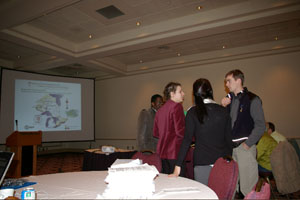KORI stresses importance of two-way sharing
By Rick Garrick Dec. 2007
 Keewaytinook Okimakanak's (KO) Health Director Robert Thomas recently lead off a regional health conference via videoconference from his office in Balmertown.
Keewaytinook Okimakanak's (KO) Health Director Robert Thomas recently lead off a regional health conference via videoconference from his office in Balmertown.
Speaking on-line from his office, Thomas opened the Building from Strength Conference with a keynote address on Innovative First Nation Mental Health Services in the Sioux Lookout Region, where he shared the successes and progress of regional mental health programs and partnerships in changing the lives of First Nation youth.
"The bottom line is that we want to demonstrate that counselling can be delivered to the remote communities using technology, such as telecounselling," Thomas says, emphasizing KO Telemedicine's telecounselling program, which is currently being delivered over an encrypted line to ensure total confidentiality to clients in the five KO communities of Deer Lake, Fort Severn, Keewaywin, North Spirit Lake and Poplar Hill. "This program has been well received by community members. It is probably the most successful in terms of dealing with social issues in the communities."
The conference was developed through a partnership between KO and Lakehead University's National Centre of Excellence for Children's Well-being and delivered Nov. 22 and 23 in Thunder Bay and on-line in 10 remote First Nation communities across the north. "KO feels it is important to share these conferences with remote First Nation communities," says Franz Seibel, KO Research Institute (KORI) researcher, adding that the conference builds on KO's work with CRACIN, RICTA, DERAC, VIDEOCOM and a host of other regional, national and international organizations.
"Not only to have the communities participating, but also to have them sharing their knowledge and experience." Margaret Boone, chief operating officer at the Centre of Excellence, stressed the importance of Thomas delivering the first keynote address. "Having Robert Thomas as the very first presenter was very good," Boone says, explaining that his opening address encouraged all the participants to keep in mind the on-line participants throughout the conference. "It was quite effective."
During his keynote address, Thomas brought up an example of the telecounselling program's success: a youth from a KO community who had been a chronic gasoline sniffer. "As a result of the program and with therapists we were able to compile a support system to give him assistance to turn his life around," Thomas says. "As of today, he is not gas sniffing anymore." Thomas stresses that the on-line aspect of the conference gave people in the communities an opportunity to create linkages with other conference participants that may help them in dealing with their community's concerns.
"The technology has been up to par in delivering these types of conferences," Thomas says. "They give people an opportunity to communicate with each other." KO provided on-line connections, resources and planning for the conference and the communities acted as hosts, supported by local technicians who played an instrumental role in coordinating the local connections.
"Our goal is to bring professional development and capacity-building workshops to remote communities," Seibel says. "And to involve community members in the planning and delivery so that the conferences are a two-way stream of information."
The technology provides an opportunity to create a dialogue between the communities and academic researchers, says Brian Walmark, KORI director. "The people understand the challenges facing their communities and they know what needs to be done," he says. "They need resources and support. Academic researchers have a lot to offer if they are willing to listen, learn and respect the needs and goals of the communities. We have an opportunity to create a learning environment which will benefit all partners."
Delivering the conference via videoconference enables the Centre of Excellence to provide information to community workers without requiring them to leave the community for the duration of the conference, Boone explains.
"We can involve more people and keep people in the community," she says. "KO has the technology, people and tools to do it." Boone is looking forward to working with KO on future conferences. The two organizations worked together on a conference last spring and were able to apply some of the lessons they learned at that time to encourage on-line participation; for instance, all of the conference materials were made available on-line at the conference website, http://meeting.knet.ca/moodle/course/view.php?id=90, each site was involved in all conference discussions, refreshments were provided at each site, and each remote site was invited to act as a storyteller during the sharing time and drumming circle session at the conclusion of the conference.
Eight other presentations were delivered during the conference, which was attended by about 250 people at the Thunder Bay site and about 30 at the remote sites: Building Strength for A Canada Fit for Children; Land Based Education: Learning to Build Strength in First Nation Communities; Bipolar Disorders in Youth; Helping Children Heal from Traumatic Events: A Caregiver's Compass; Self Harm Syndrome; Pathways to Resilience through Child Welfare, Corrections, Mental Health and Educational Settings: Recommendations for Collaboration; A Strength Based Approach to Manage Challenging Behaviours in Children and Adolescents; and Arts Engagement with Youth, Beedaubin Resources.
"The Centre of Excellence involved KO in the planning so that we could help shape the agenda and invite abstracts from First Nation communities," Seibel says, noting that the Centre of Excellence understands the importance of two-way sharing. "In addition, they were very open to having the delivery of the conference very on-line oriented."
| Preview | Attachment | Size |
|---|---|---|
| KORI stresses importance of two.pdf | 21.87 KB |
